Mazda3 Gains Style, Luxury, Technology in 2019 Redesign
By John Gilbert
Ever since Mazda decided to revise its entire line and change the compact Protege’s name to Mazda3, it has been among my favorite cars in the world. Smooth and well-proportioned lines, great handling balance, and the legendary “zoom-zoom” Mazda engine technology that provided more content than its price would indicate.
For three generations, the Mazda3 has set a new standard among compacts, even including the stalwarts, Honda Civic and Toyota Corolla. The third generation definitely lifted the car to prominence among engineering snobs, adding the incredible technology of Skyactiv engineering, so for 2019, it didn’t seem that Mazda needed to come out with another new generation quite yet.
But the little company from Hiroshima wanted to round up all its recent advances in technology and it was impatient for a new model to properly house it, so the fourth generation hit the showrooms for 2019. You can’t disagree with the decision, because the new sedan looks like a sleek and sportier downsized Mazda6, and the new hatchback is a different car with a different personality, and it is my new favorite. It has a sort of elongated occupant compartment and from the rear corner, it looks like it might be a compromise between a car and an SUV.
It is, of course, too low-slung and sporty to be an SUV, but the cargo room under the hatch is remarkable, and you can flip down the rear seat backrest and expand it more. Plus, among the notable additions such as a clean and efficient interior is a unique, in-house designed all-wheel drive, which lifts the Mazda3 up above its prime competitors like the Honda Civic, Toyota Corolla and the revised Hyundai Elantra GT.
Here’s the only downside is that Mazda3 always has been a bargain in the compact segment, boasting sophisticated features unexpected in a compact, but for 2019, it might be departing the “bargain” status, because the the advanced technology forces it upscale enough to warrant a rise in sticker price.
The loaded test car, in Polymetal Gray Mica, reached $31,000, which is still reasonable if you examine and appreciate the engineering.
I just drove a 2019 Mazda3 Hatchback in Polymetal Gray Mica, with the Premium Package goodies, most of which are very impressive. Hand-to-hand combat with the radio controls took us most of the week, and nobody can convince me there was a need to make it so needlessly complex in the name of luxury. Gone are the good-ol’ days when a Mazda radio featured three buttons on either side of a large knob. Without taking your eye off the road you could push the knob and the radio came on, turn it and you increase or decrease the volume, while the six buttons on either side are presets. What a concept! Once on, it never seemed to keep our memorized settings the next time we started up. The new Bose 12-speaker audio is very good once on, unless you try something as outlandish as changing the station, or switching from AM to FM or satellite. Coordinating your smartphone with the car also is more complex just as most other cars have figured out simplifying it. But if you owned it, you’d set it and never change it. I think.
Climb into the comfortable and supportive driver’s seat, and you’re immediately impressed by the very feel of more luxury, from the steering wheel, and the gauges on the instrument panel, to the console, which is classy in gloss “piano” black, although I question the use of any gloss black surfaces because they reflect glare, and if they don’t, it’s because they comfortably house every fingerprint in the vicinity. The shift lever for the 6-speed automatic is easy to operate — no CVT for the Mazda3; these guys are zoom-zoom to the soul. I also appreciate the openness of the dashboard, which seems far away from the passenger, because it is, in a clever design to add to the spaciousness. The padded shelf is sloped, undoubtedly to eliminate motivation for stashing stuff on it. because you risk getting it in your lap at an unscheduled moment.
There is a high, centered 8.8-inch navigation screen that can show all the connectivity stuff, including the audio, cell-phones and the vehicle’s operation details. The car is equipped with radar cruise as well as all the lane-detection, back-up camera, head-up display on the windshield, blind-spot detection, and cross-traffic alert at the rear, among its all safety items. Much improved sound insulation also stifles road noises and aids the luxury movement.
Fittingly for the Mazda3 being worth every penny of the sticker — base $28,900, as-tested $32,460 — is the fully evidence that it was engineered, designed and built by car guys, with purpose. This wasn’t put together by social-climbing preppies or someone trying to win soft-and-cushy awards.
The prime ingredients will impress hard-core car people, while possibly inducing a yawn from those who just want transportation without details, including media types, who might rather not be bothered with details of the various features, let alone the combination of all of them. But we will check them off.
First, Skyactiv is not new anymore, but is the product of a clean-sheet idea to change the way Mazda was making engines, with an eye to the future. All the high-efficiency tricks were put together in both the 2.5 and the increasingly scarce 2.0, such as Atkinson-cycle valve-train timing, which can increase or decrease the time the valves open and shut, for more complete burning of all the fuel in the cylinder, which has been metered precisely by direct injection.
Putting all together means the standard 2.5-liter 4-cylinder engine in the Mazda3 has a 13-to-1 compression ratio, but still calls for regular fuel, while producing 186 horsepower, a lot for a compact, and a matching 186 foot-pounds of torque, which is the primary benefit to its pulling power. The horsepower peaks at 6,000 RPMs and the torque at 4,000. The EPA estimate for the test vehicle shows 24 city and 32 highway, but we had trouble getting it over 22 miles per gallon, no matter how we drove it, including shifting by the steering wheel paddles, and trying the mode switch toggled to “sport.” That switch can summon up tightened suspension, heavier steering feel, and a more aggressive shift mapping, and it defaults back to normal every time you switch the ignition off.
The best-kept secret might be Mazda’s G-Vectoring magic, which is the product of 10 years of engineering and trial-and-error refinement. A computerized control system governs the front wheels. When you turn sharply into a curve or a corner, you use your instincts and experience for when to turn. The “turn-in,” as it’s called, is as precise as you make it, and if it isn’t perfect, you correct by counter-steering, to find your trajectory. If you correct too severely, you need to correct again. Actually, that can be fun on a road-racing course, because you induce a little tail-wagging that enhances your feeling of speed.
But on the streets and highways, it gets serious. A less-skilled or inattentive driver might make a bad turning moment, and then need to correct and possibly correct again. That’s a good way to lose control. The best-handling cars are those that turn precisely as you aim them, or are easily corrected with one adjustment when you miss.
Mazda’s engineers worked many tests until they ascertained that when a driver starts to turn in, the car should respond precisely, and while it seems counter to instincts, the G-Vectoring system does two things at the first millisecond’s recognition that you’re making a turn. First, it softens the shock absorber on the outside front wheel for a millisecond — while instinct says you might want to stiffen it. Second, the computer reduces the torque to the outside front wheel, again, for just a couple milliseconds, then returns to normal. By doing those two things, the car’s outside front tends to bob down ever so slightly, and you certainly don’t feel it, but it does convince you that you’ve chosen the right turn-in.
While driving, you feel none of that technology at work. The only thing you notice is that after zooming around turns and corners, you haven’t ever needed to correct. You just keep going, with no skidmacks or screeching of tires, and all you felt was that this might be the most precise cornering car you’ve ever driven. It is the perfect definition of the cliche about feeling like riding on rails.
The third special element is the all-wheel drive system. Mazda has had an impressive all-wheel drive system for its CX-3, CX-5 and CX-9 SUV fleet, but it chose not to use the same system for the Mazda3. Instead, its computer calculates the vertical load on each wheel, combined with the vehicle’s speed, your steering tendency, and input from an accelerometer and a yaw-sensor, to calculate if a potential spin is threatened. When it senses slippage, the system seamlessly puts all four wheels to work for optimum traction. If it senses no potential slippage, it sends more torque to the rear wheels, aiming for better traction when you accelerate in normal weather.
The six-speed automatic is geared for cruising, and it doesn’t have the neck-snapping off-the-line power some rivals might have, earning complaints from drivers who don’t like driving all that much. But it’s set up to run efficiently at highway speeds. The shift paddles allow you to downshift for more revs if you need instant power, or to upshift manually if you choose. So downshift and step on the gas and the power is easily adequate.
Some of those features can surprise you. For instance, I was driving along on some city streets and it started raining. Not heavy, just a sprinkle, and while I was thinking about whether I should reach for the wiper switch, the wipers came on! Almost as if I caused the activation with my thought process. The rain-sensing kept up a pretty good pace until the sprinkles ended. Handy.
By coincidence, the new Mazda3 also played a role in what now is a departure from this review. After studying and testing cars for a lot of years, the rise of a new breed of car media types are pushing some legitimate and long-standing auto writers off the manufacturers’ lists for invitations to the introductions of new cars, putting more value on social media hits. I’m among those affected, and it bothers me because I always have enjoyed seeking out the inside stories of engines and design features, which I relay to readers. Much new-age coverage seems to focus more on how soft the dashboard is than new engine or suspension technology.
With that as a preface, I submit as Exhibit A, the August, 2019 issue of Car and Driver magazine. Always in a monthly duel with Motor Trend to be the trusted source of auto news, C and D has always had a chippy, irreverent edge to covering cars that I’ve enjoyed, although in its last regime, that seemed to be changing. For August, there is a comparison test of the manual transmission versions of the top compacts. After describing pluses and minuses of each, the magazine ranked the Toyota Corolla fifth and last earning 157 points on the various criteria; the Volkswagen Golf SE fourth with 189; the Hyundai Elantra GT third with 192; the Mazda3 second with 194; narrowly edged by the winner, the Honda Civic with 196.
Reasonable, because all five compacts are impressive on their own, and 196-194 is certainly close for the win. But look at the evaluation, the Mazda3 won the vehicle section, and the powertrain segment. In the next segment, Car and Driver gave the Civic a 2-point edge in steering feel, and brake feel, and a 3-point edge in handling, while Mazda had a 1-point edge in ride. They call that segment “chassis” and I consider it subjective, and while it showed the Civic with a best 55 points and the Mazda3 second-worst at 48, that still left the Mazda3 as the overall winner. But, as it always does in its comparisons, the magazine adds a most-subjective item, “fun to drive,” where the Civic scored 23 and the Mazda3 only 16 — a 7-point margin that lifted the Civic above the Mazda3 by 2 points. You can form your own opinions or suspicions.
That in no way diminishes the Honda Civic, which is an outstanding car, and it might have won straight up, but my suspicions blossomed by reading the overview by Annie White, who was assigned to put it all together for my trusted hard-core car enthusiast magazine. She wrote numerous reasons why the Mazda3 fell short, starting with it “isn’t that fun to drive anymore,” and that it “isn’t the great driving car it used to be,” and her conclusion was that “It doesn’t stand up to hard driving quite the same way,” and she quoted a fellow writer saying, “This is a car that reels worse the harder you drive it.”
OK, opinions can vary. I totally disagree with the statement that it doesn’t handle, and handles worse in hard driving, or that its steering lacks feel. And while my test car had all-wheel drive, I have driven the front-wheel-drive stick version. My surprise is that never was there any mention of the unique G-Vectoring, and the criticism means that this group of hard-charging, macho-sporty drivers never mentioned — and possibly never noticed — the benefit of never needing to correct the steering wheel in hard cornering.
Mazda only offers the stick shifts in the top of the line Mazda3 models, and I’ve driven the front-wheel drive Mazda3 that these folks tested for their comparison, and found it might handle a little sportier than the AWD model because its a little lighter. My bigger question is whether the C and D staff members, writing for intense car fanatics, have shifted their objectives to join the purveyors of padded dashboards and can no longer be trusted to notice, comprehend, and explain major technical advancements.


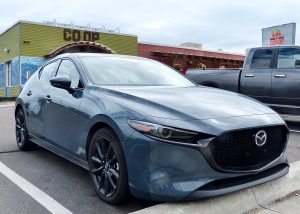
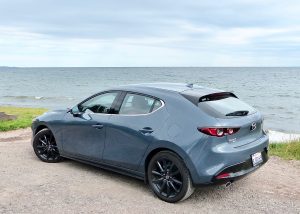
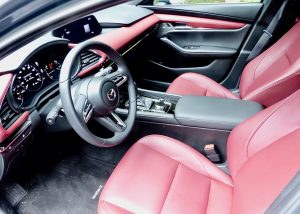
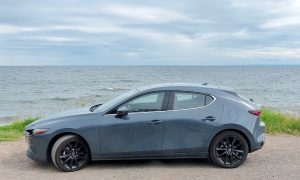
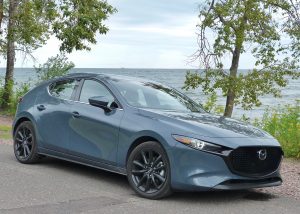
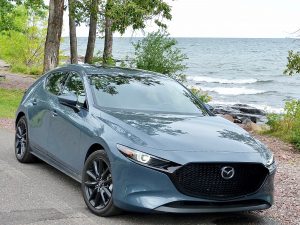
 John Gilbert is a lifetime Minnesotan and career journalist, specializing in cars and sports during and since spending 30 years at the Minneapolis Tribune, now the Star Tribune. More recently, he has continued translating the high-tech world of autos and sharing his passionate insights as a freelance writer/photographer/broadcaster. A member of the prestigious North American Car and Truck of the Year jury since 1993. John can be heard Monday-Friday from 9-11am on 610 KDAL(www.kdal610.com) on the "John Gilbert Show," and writes a column in the Duluth Reader.
John Gilbert is a lifetime Minnesotan and career journalist, specializing in cars and sports during and since spending 30 years at the Minneapolis Tribune, now the Star Tribune. More recently, he has continued translating the high-tech world of autos and sharing his passionate insights as a freelance writer/photographer/broadcaster. A member of the prestigious North American Car and Truck of the Year jury since 1993. John can be heard Monday-Friday from 9-11am on 610 KDAL(www.kdal610.com) on the "John Gilbert Show," and writes a column in the Duluth Reader.